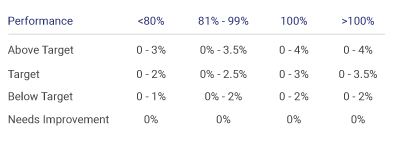Merit Matrices: What Are the Compa Ratio and Market Index
A merit matrix is a mathematical grid that compensation professionals provide as a management tool to support efficient and consistent administration of salary increases to employees. A merit matrix is a two-factored table that considers performance rating and some measure of relative salary placement, typically compa ratio. It is designed to provide a framework to help managers equitably navigate the allocation of merit increases across their employee population. A merit matrix should be structured to fairly reward high-performing employees similarly across the company to reduce the risk of salary-increase inequality. Since pay increases are most frequently made as a percent of salary, this may result in high-performing employees receiving the same percent increases across the organization, independent of the position.
What Is the Compa Ratio? How Does It Relate to Salary Benchmarking?
Compa ratio is the relationship of base pay to the salary grade midpoint and is expressed as a percentage. It is calculated by dividing the actual salary by the midpoint of the corresponding salary range.
For example: If an engineer earns an annual salary of $162,000, and the salary midpoint for the position is $165,000, then the compa ratio is 98.18% ($162,000/$165,000).
From this comparison, it is concluded that the engineer’s salary represents approximately 98% of the range midpoint. But what exactly does the midpoint represent? The midpoint of the salary range represents market value, as defined by the compensation philosophy. Some companies pay at market median or the 50th percentile, or maybe the 75th percentile for senior management level jobs. It all depends on the company’s pay philosophy and compensation strategy. Salary ranges and midpoints must be reviewed periodically to make certain they remain connected to market value. Periodic checks on the grading structure are important when using this comparison.
All of this is important in being able to make a simple comparison across employees in different ranges. When reviewing salaries, a compa ratio in one title may represent different salaries but the same percentage, which can then be evaluated evenly. So, a compa ratio of 80% may be considered low, but in terms of absolute dollar value, the highest paid may be comparatively less well paid than others on the team. All could have the same compa ratio while earning vastly different salaries. Compa ratio should be used to determine where employees are in relation to midpoint and their performance. The simplified merit matrix below illustrates the range of increases available for distribution of the increases:

What Is the Market Index?
In contrast to the compa ratio, which compares base salary to internal structures, the market index compares base salary to the external marketplace. Market index is a ratio that compares salaries to the market average for those positions, assuming that the jobs are appropriately benchmarked and market priced. Using market index as a comparator to the target position of the company (median, mean, 50th percentile, etc.) may be a better indicator of whether some job families need an adjustment or not. For example, if the average market index within a grade is 110%, then those employees would be 10% above market. This might be desired if an organization is targeting a market position 10% above market, and the market index allows for measurement of that target.
These statistical tools are just that – tools. They are not meant to be taken at face value in every situation. A low compa-ratio in a company that pays higher than most is not necessarily a bad thing to be remedied immediately. Each requires an investment of time to know the company’s jobs, talent, compensation challenges, what’s working and what isn’t, and where the gaps in salary equity are. Use the tools that work best for accomplishing the strategic goals of the organization. For more information on how to properly benchmark pay for different jobs by experience, location, and more, see SalaryExpert’s blog, which covers topics ranging from total compensation benchmarking to geographic salary differentials.
